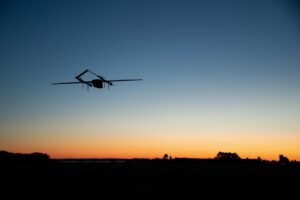The Naval Air Warfare Center Aircraft Division (NAWCAD) acquired a logistics Unmanned Air System (UAS) prototype in October to demonstrate long-range naval ship-to-ship and ship-to-shore cargo transport and it is now set for further tests in the fleet.
The Navy said the NAWCAD engineers, testers and military test pilots are evaluating this vehicle, called the Blue Water Maritime Logistics UAS, and tailoring it to requirements set by Fleet Forces Command and Military Sealift Command (MSC). The service revealed the aircraft on Nov. 9.

The Navy is using a Group-3 class UAS from Skyways Air Transportation Inc.
The service noted in historical casualty report data warships often move to partially or non-mission capable status often because of logistics-related issues, with most needed parts weighing under 50 pounds. Currently H-60 helicopters and V-22 tilt-rotor aircraft fly missions to provide the parts, but the Navy is investigating using this kind of Group-3 size UAS.
The Navy previously solicited industry to demonstrate potentially viable platforms that currently exist commercially that could autonomously transport a 20-pound payload to a moving ship 25 miles away without refueling. The Navy analyzed over 65 UASs and two were advanced enough to partially meet requirements. The two finalists were tested during NAWCAD’s first Advanced Naval Technology Test Exercise in 2019.
“We planned the demo during NAWCAD’s first Advanced Naval Technology Test Exercise in 2019 because we wanted to test the systems in a realistic and simulated forward-deployed environment,” Blue Water project lead Bill Macchione said in a statement.
“NAWCAD engineers and pilots observed and provided honest naval assessment based on which system was easiest to operate and maintain, had solid design, and required least modification for the mission,” he continued.
NAWCAD then selected the Group-3 Skyways platform based on its performance in the 2019 demonstration. The Navy argued the Skyways’ small UAS has the needed size, payload capacity, and range potential for this maritime environment operation.
The UAS arrival at NAWCAD’s unmanned Air Test and Evaluation Squadron (UX) 24 recently is the beginning of civilian and military training, with additional system development expected to better meet MSC requirements.
“NAWCAD intends to work with the contractor to create a better fit with the environment where it could potentially operate. We’re excited to get to work on such innovations as folding wings for better handling and ship storage, a dual propulsion system that runs on both electricity and JP-5 [fuel], an internal versus external cargo capacity, and an automatic dependent surveillance broadcast identification system,” Macchione added.
The Blue Water system is planned to undergo experimentation with the fleet in the Atlantic Ocean during most of 2021.
Blue Water’s co-lead and experimentation engineer James Tomasic said the results of the technical feasibility and technology demonstration efforts will be shared and used to discuss transition to support fleet initiatives.
“Culmination of the effort with the Fleet during a Naval Warfare Development Command experiment later this year will provide pertinent information for the Office of the Chief of Naval Operations, which determines requirements and future force structures for the Department of the Navy,” Tomasic said.
Macchione underscored the Blue Water UAS cargo requirement cannot be compared to online retailers like Amazon [AMZN].
“Naval cargo transport requires vehicles that can successfully operate through difficult environments that include heavy winds, open water and pitching vessels at sea,” Macchione said.